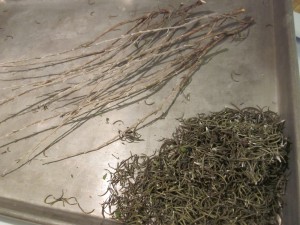Dehydrating Herbs: Fresh Today, Dehydrated this Winter!

Growing herbs is a pastime of mine. My garden contains numerous varieties—from garlic and onion chives to lavender and rosemary. When the weather starts to get cooler, I start to dehydrate my favorites.
All summer long I keep an eye on my dill, as I save the seeds to dry. I have a killer cottage cheese dill quick bread recipe that I love to use it in. I replant my dill at least three times throughout the summer to grow enough for cooking and to share with the caterpillars! It’s the same with cilantro. The secret is to replant frequently. I use this fresh—it is better that way.
I cut my chives in the morning when the dew evaporates, as the strength of the herbs is the strongest then. I wash them and pat them dry, and then I place them in a single layer either on a dehydrator rack or on a cooling rack placed on a cookie sheet and dehydrate them in a low oven with the door cracked. This allows the moisture to escape. I also do this for my rosemary and lavender. It works well for sage and thyme too.
If I am in a hurry, I place clean herbs on a microwave safe plate, with a layer of microwave safe paper towels on top and underneath. I microwave them for a minute first, and then set it for every thirty seconds until they are dry. This works well for small amounts of herbs.
After you have dried your herbs, they need to be stored in air tight containers away from heat, moisture and light for best flavor. When dehydrating rosemary, I save the woody sticks after removing the herb to either use as skewers on the grill with pineapple, peppers and onions, or else I throw them in the fire in the grill to smoke my veggies. It makes them taste so great!
For more great blogs on dehydrating and healthy recipes, check out more Recipe Redux blogs!





